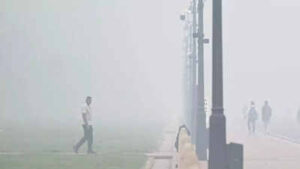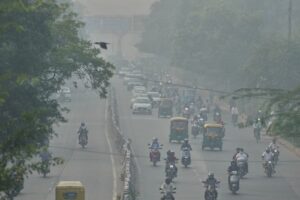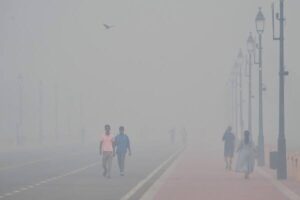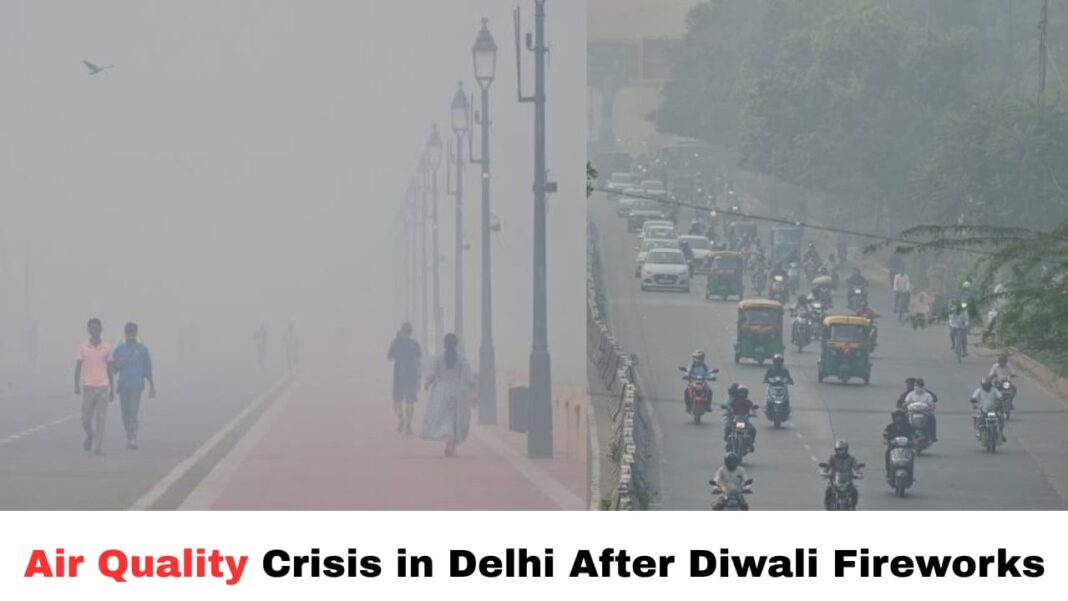Digital News Guru New Delhi Desk:
Air quality crisis in New Delhi following Diwali fireworks
The capital region of India, New Delhi, is facing a sharp air-quality emergency in the immediate aftermath of the Diwali festival. On October 21 2025, the city’s air-quality indicators plunged into levels labelled “very poor” and “severe,” raising alarm among residents, health experts and policymakers alike.
A sudden spike in pollution
According to monitoring by Swiss group IQAir, Delhi logged an Air Quality Index (AQI) of 442, making it the world’s most polluted major city at the time. In many parts of the city, readings exceeded 400 — a threshold signifying “severe” pollution. The local Central Pollution Control Board (CPCB) confirmed multiple stations reported readings in the 300-400 “very poor” bracket.

The deterioration was notable: 36 of Delhi’s 38 air-quality monitoring stations reported “red-zone” levels—meaning very poor to severe — in the wake of Diwali fireworks.
Why did this happen?
Several overlapping factors contributed to this crisis:
- Fireworks during Diwali: Firecracker bursting during Diwali is a recurrent trigger for sharp rises in particulate matter (PM2.5 and PM10) in Delhi. In 2025, despite court-imposed restrictions, many fireworks use escalated, adding to the pollution burden.
- “Green crackers” & limited enforcement: The Supreme Court of India permitted “green” firecrackers—products intended to reduce emissions by 30-50%—and restricted their usage to certain hours. However, experts warned that even these reduced-emission crackers cannot prevent air-quality collapse if mass usage persists.
- Seasonal meteorology & other pollution sources: The festival falls in a transition period where cooler nights, low wind speeds, and upper-air inversion layers trap pollutants near the surface. Combined with vehicle emissions, construction dust and crop-residue burning in neighbouring states, the air stagnates.
Health and social implications
For a city with over 20 million residents, the implications are serious:
- High levels of PM2.5 (fine particulate matter) and PM10 are linked to increased hospital admissions for asthma, bronchitis, heart disease, and other respiratory and cardiovascular ailments.
- Even healthy individuals face elevated risk when AQI breaches 300-400; vulnerable groups such as children, the elderly and people with existing health conditions face greater threats.
- The smog also affects visibility, quality of life and outdoor activities. The grey haze enveloping the city created visible disruption and community concern.

Response and policy measures
Given the severity, authorities have activated response measures:
- The region triggered Stage II of the Graded Response Action Plan (GRAP), which includes tighter controls on construction activities, limiting diesel generator usage, mechanised road-sweeping, regulating waste-burning and other dust-suppressant measures.
- Short-term curbs: Non-essential construction was suspended, dust suppression measures intensified and public advisories issued urging reduced outdoor exposure.
Yet, while such measures may provide short-term relief, environmentalists stress they do not substitute for long-term structural reforms—strengthening emissions standards, phasing out older vehicles, reducing dependency on fireworks, and coordinating regionally.
Looking ahead: what to watch
- Resume of poor air quality: Meteorologists predict the AQI may remain in the 300-400 (“very poor” to “severe”) range for several days given stagnant weather conditions and residual emissions.
- Festive habits vs environment: Diwali’s fireworks tradition may require deeper behavioural change if pollution spikes are to be mitigated. The balance between cultural practices and public health is under increasing scrutiny.
- Regional cooperation: Many of Delhi’s pollution sources are beyond municipal limits—crop residue burning in Punjab/Haryana, dust from construction and industrial emissions in neighbouring regions. Effective solutions will require multi-state coordination.
- Data-driven interventions: Research continues to highlight how emission sources (e.g., firecrackers vs biomass burning) contribute during seasonal pollution episodes. Better source apportionment could inform more targeted policy.
- Public awareness and behaviour: The citizen response—mask use, limiting outdoor exposure, avoiding heavy physical activity—remains key in protecting vulnerable groups until structural change takes effect.

Conclusion
The post-Diwali surge in air pollution in Delhi is a sharp, yet not unexpected, manifestation of an annual cycle of environmental pressure. The readings crossing the “severe” threshold underscore a harsh reality: the city’s air-quality management framework is being tested again. While fireworks provide an immediate surge in pollutants, the underlying vulnerability lies in policy gaps, enforcement challenges and the complexity of metropolitan air-shed dynamics.
For residents and visitors alike, the message is clear: this is not “just another winter haze.” With the AQI breaching 400, the health risk is real and urgent. In the longer term, Delhi and India’s northern region face a critical juncture—either to move rapidly toward integrated emissions control, cleaner mobility and reduced reliance on high-pollution festive norms—or to accept that each year, the festival of lights will increasingly cast a darker pall on the air we breathe.
You May Also Read: Enrique Iglesias Returns to India After 13 Years: Mumbai Shows Oct 29–30, 2025








